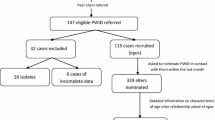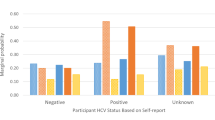Abstract
Factors associated with syringe sharing differ between women and men; however, it is uncertain whether these hold within the setting of a single injection episode. A questionnaire eliciting information about the last injection episode with others present was administered to participants in a cohort of Montréal injection drug users (IDUs). Logistic regression was used to identify correlates of syringe sharing and to test potential gender differences in relation to syringe sharing. Data from 467 participants revealed significant differences between men and women with regard to situational factors; however, the relationships between situational factors and syringe sharing did not vary according to gender. In multivariate models including both genders, syringe sharing was associated with various attributes of other IDUs who were present as well as alcohol use during that specific episode. These results highlight the relevance of situational factors in injection drug use activity, regardless of gender.
Similar content being viewed by others
References
Bourgois, P. (1998). The moral economies of homeless heroin addicts: Confronting ethnography, HIV risk, and everyday violence in San Francisco shooting encampments. Substance Use and Misuse, 33, 2323–2351. doi:10.3109/10826089809056260.
Breen, C., Roxburgh, A., & Degenhardt, L. (2005). Gender differences among regular injecting drug users in Sydney, Australia, 1996–2003. Drug and Alcohol Review, 24, 353–358. doi:10.1080/09595230500263871.
Bruneau, J., Daniel, M., Kestens, Y., Zang, G., & Généreux, M. (2008). Associations between HIV-related injection behaviour and distance to and patterns of utilisation of syringe-supply programs. Journal of Epidemiology and Community Health, 62, 804–810. doi:10.1136/jech.2007.064154.
Bruneau, J., Lamothe, F., Soto, J., Lachance, N., Vincelette, J., Vassal, A., et al. (2001). Sex-specific determinants of HIV infection among injection drug users in Montreal. Canadian Medical Association Journal, 164, 767–773.
Cruz, M. F., Mantsios, A., Ramos, R., Case, P., Brouwer, K. C., Ramos, M. E., et al. (2007). A qualitative exploration of gender in the context of injection drug use in two US-Mexico border cities. AIDS and Behavior, 11, 253–262. doi:10.1007/s10461-006-9148-9.
De Beck, K., Shannon, K., Wood, E., Li, K., Montaner, J., & Kerr, T. (2007). Income generating activities of people who inject drugs. Drug and Alcohol Dependence, 91, 50–56. doi:10.1016/j.drugalcdep.2007.05.003.
Des Jarlais, D. C., Perlis, T., Arasteh, K., Hagan, H., Milliken, J., Braine, N., et al. (2004). “Informed altruism” and “partner restriction” in the reduction of HIV infection in injecting drug users entering detoxification treatment in New York City, 1990–2001. Journal of Acquired Immune Deficiency Syndromes, 35, 158–166. doi:10.1097/00126334-200402010-00010.
Evans, J. L., Hahn, J. A., Page-Shafer, K., Lum, P. J., Stein, E. S., Davidson, P. J., et al. (2003). Gender differences in sexual and injection risk behavior among active young injection drug users in San Francisco (the UFO Study). Journal of Urban Health, 80, 137–146. doi:10.1093/jurban/jtg137.
Fitzgerald, T., Lundgren, L., & Chassler, D. (2007). Factors associated with HIV/AIDS high-risk behaviours among female injection drug users. AIDS Care, 19, 67–74. doi:10.1080/09540120600731727.
Frajzyngier, V., Neaigus, A., Gyarmathy, V. A., Miller, M., & Friedman, S. R. (2007). Gender differences in injection risk behaviors at the first injection episode. Drug and Alcohol Dependence, 89, 145–152. doi:10.1016/j.drugalcdep.2006.12.021.
Freeman, R. C., Rodriguez, G. M., & French, J. F. (1994). A comparison of male and female intravenous drug users’ risk behaviors for HIV infection. The American Journal of Drug and Alcohol Abuse, 20, 129–157. doi:10.3109/00952999409106779.
Friedman, S. R., de Jong, W., Rossi, D., Touze, G., Rockwell, R., Des Jarlais, D. C., et al. (2007). Harm reduction theory: Users’ culture, micro-social indigenous harm reduction, and the self-organization and outside-organizing of users’ groups. The International Journal on Drug Policy, 18, 107–117. doi:10.1016/j.drugpo.2006.11.006.
Hagan, H., Des Jarlais, D. C., Stern, R., Lelutiu-Weinberg, C., Scheinmann, R., Strauss, S., et al. (2007). HCV synthesis project: Preliminary analyses of HCV prevalence in relation to age and duration of injection. The International Journal on Drug Policy, 18, 341–351. doi:10.1016/j.drugpo.2007.01.016.
Hosmer, D., & Lemeshow, S. (2000). Applied logistic regression (2nd ed.). New York: Wiley-Interscience Publication.
Hudgins, R., McCusker, J., & Stoddard, A. (1995). Cocaine use and risky injection and sexual behaviors. Drug and Alcohol Dependence, 37, 7–14. doi:10.1016/0376-8716(94)01060-X.
Koester, S., Glanz, J., & Baron, A. (2005). Drug sharing among heroin networks: Implications for HIV and hepatitis B and C prevention. AIDS and Behavior, 9, 27–39. doi:10.1007/s10461-005-1679-y.
Lakon, C. M., Ennett, S. T., & Norton, E. C. (2006). Mechanisms through which drug, sex partner, and friendship network characteristics relate to risky needle use among high risk youth and young adults. Social Science and Medicine, 63, 2489–2499. doi:10.1016/j.socscimed.2006.06.015.
Latkin, C., Mandell, W., Vlahov, D., Oziemkowska, M., Knowlton, A., & Celentano, D. (1994). My place, your place, and no place: Behavior settings as a risk factor for HIV-related injection practices of drug users in Baltimore, Maryland. American Journal of Community Psychology, 22, 415–430. doi:10.1007/BF02506873.
Leigh, B. C. (2002). Alcohol and condom use: A meta-analysis of event-level studies. Sexually Transmitted Diseases, 29, 476–482. doi:10.1097/00007435-200208000-00008.
Lum, P. J., Sears, C., & Guydish, J. (2005). Injection risk behavior among women syringe exchangers in San Francisco. Substance Use and Misuse, 40, 1681–1696. doi:10.1080/10826080500222834.
Miller, C. L., Kerr, T., Frankish, J. C., Spittal, P. M., Li, K., Schechter, M. T., et al. (2006). Binge drug use independently predicts HIV seroconversion among injection drug users: Implications for public health strategies. Substance Use and Misuse, 41, 199–210. doi:10.1080/10826080500391795.
Miller, C. L., Strathdee, S. A., Li, K., Kerr, T., & Wood, E. (2007). A longitudinal investigation into excess risk for blood-borne infection among young injection drug users (IUDs). The American Journal of Drug and Alcohol Abuse, 33, 527–536. doi:10.1080/00952990701407397.
Nicolosi, A., Musicco, M., Saracco, A., Molinari, S., Ziliani, N., & Lazzarin, A. (1990). Incidence and risk factors of HIV infection: A prospective study of seronegative drug users from Milan and northern Italy, 1987–1989. Epidemiology (Cambridge, Mass), 1, 453–459. doi:10.1097/00001648-199011000-00007.
Platt, L., Rhodes, T., Lowndes, C. M., Madden, P., Sarang, A., Mikhailova, L., et al. (2005). Impact of gender and sex work on sexual and injecting risk behaviors and their association with HIV positivity among injecting drug users in an HIV epidemic in Togliatti City, Russian Federation. Sexually Transmitted Diseases, 32, 605–612. doi:10.1097/01.olq.0000175391.13947.f7.
Rhodes, T. (2002). The ‘risk environment’: A framework for understanding and reducing drug-related harm. The International Journal on Drug Policy, 13, 85–94. doi:10.1016/S0955-3959(02)00007-5.
Ross, M. W., Wodak, A., Miller, M. E., & Gold, J. (1993). Sexual partner choice in injecting drug users from a “critical incident” measure: Its implications for estimating HIV spread. Sexological Review, 1, 77–92.
Secteur Vigie et Protection. Direction de la Santé Publique, Agence de la santé et des services sociaux de Montréal. (2006). Recrudescence d’infections par le virus de l’immunodéficience humaine (VIH) et le virus de l’hépatite C (VHC) chez les utilisateurs de drogues injectables (UDI) de Montréal. Retrieved September 15, 2008, from http://www.santepub-mtl.qc.ca/Mi/itss/vihsida/31082006.html.
Sherman, S. G., & Latkin, C. A. (2002). Drug users’ involvement in the drug economy: Implications for harm reduction and HIV prevention programs. Journal of Urban Health, 79, 266–277. doi:10.1093/jurban/79.2.266.
Sherman, S. G., Latkin, C. A., & Gielen, A. C. (2001). Social factors related to syringe sharing among injecting partners: A focus on gender. Substance Use and Misuse, 36, 2113–2136. doi:10.1081/JA-100108439.
Small, W., Rhodes, T., Wood, E., & Kerr, T. (2007). Public injection settings in Vancouver: Physical environment, social context and risk. The International Journal on Drug Policy, 18, 27–36. doi:10.1016/j.drugpo.2006.11.019.
Stein, M. D., Charuvastra, A., Anderson, B., Sobota, M., & Friedmanna, P. D. (2002). Alcohol and HIV risk taking among intravenous drug users. Addictive Behaviors, 27, 727–736. doi:10.1016/S0306-4603(01)00205-2.
Stein, M. D., Hanna, L., Natarajan, R., Clarke, J., Marisi, M., Sobota, M., et al. (2000). Alcohol use patterns predict high-risk HIV behaviors among active injection drug users. Journal of Substance Abuse Treatment, 18, 359–363. doi:10.1016/S0740-5472(99)00070-7.
Stimson, G. V., Jones, S., Chalmers, C., & Sullivan, D. (1998). A short questionnaire (IRQ) to assess injecting risk behaviour. Addiction (Abingdon, England), 93, 337–347. doi:10.1046/j.1360-0443.1998.9333373.x.
Tortu, S., McMahon, J. M., Hamid, R., & Neaigus, A. (2003). Women’s drug injection practices in East Harlem: An event analysis in a high-risk community. AIDS and Behavior, 7, 317–328. doi:10.1023/A:1025452021307.
Unger, J. B., Kipke, M. D., De Rosa, C. J., Hyde, J., Ritt-Olson, A., & Montgomery, S. (2006). Needle-sharing among young IV drug users and their social network members: The influence of the injection partner’s characteristics on HIV risk behavior. Addictive Behaviors, 31, 1607–1618. doi:10.1016/j.addbeh.2005.12.007.
Acknowledgments
We would like to acknowledge Élisabeth Deschesnes, Didier Jutras-Aswad, Martin Rioux, Geng Zang, and the other staff at the Saint-Luc Cohort research site for sharing their wisdom and expertise during the data analysis and interpretation phases of this project. Dr. Abby Lippman provided feedback throughout the writing process. We are grateful to Dr. Stephanie Tortu who provided us with a validated event-analysis questionnaire that served as the basis for this investigation. We extend special thanks to the Saint-Luc Cohort participants, without whom this study would not have been possible. Supported by grants from Canadian Institutes of Health Research, and by le Réseau SIDA- maladies infectieuses du Fonds de Recherche en Santé du Québec.
Author information
Authors and Affiliations
Corresponding author
Rights and permissions
About this article
Cite this article
Hottes, T.S., Bruneau, J. & Daniel, M. Gender-Specific Situational Correlates of Syringe Sharing During a Single Injection Episode. AIDS Behav 15, 75–85 (2011). https://doi.org/10.1007/s10461-009-9530-5
Received:
Accepted:
Published:
Issue Date:
DOI: https://doi.org/10.1007/s10461-009-9530-5




